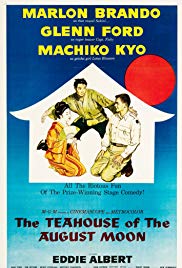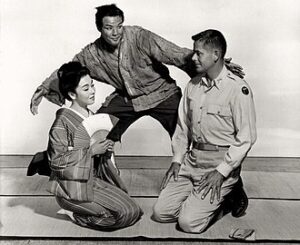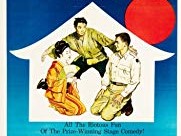The Teahouse of the August Moon *** (1956, Marlon Brando, Glenn Ford, Machiko Kyô, Eddie Albert, Paul Ford, Harry Morgan) – Classic Movie Review 9,472
Marlon Brando stars in the awkward 1956 comedy drama film The Teahouse of the August Moon about US troops confronting Oriental culture in Okinawa. Brando shows a rare comic touch, but it is very uncomfortable seeing him play an Asian character.
Director Daniel Mann’s interesting but awkward 1956 comedy drama The Teahouse of the August Moon finds Marlon Brando assuming David Wayne’s stage role as the interpreter Sakini in MGM’s version of the popular Tony best play award-winning 1953 Broadway show about American troops confronting Oriental culture in Okinawa.
Brando helps along a palatable, amusing satire of heavy-handed post-Second World War Americanisation. But it is unlikely to be anyone’s favourite Brando movie.
There is little attempt to disguise the theatrical origins, but Brando – with protruding teeth and a shiny black wig – is highly watchable, showing a rare comic touch, though of course it is very uncomfortable seeing him play an Asian character and spouting wise homilies.
Playing an Okinawan villager led method actor Brando to spend two months studying local culture, speech and gestures. During the shoot, he spent two hours each day having make-up applied to try to make him look Asian.
John Patrick’s screenplay is based on his own 1953 Pulitzer-Prize-winning and Tony Award-winning Broadway play, adapted from a 1951 novel by Vern J Sneider.
It also stars Glenn Ford, Eddie Albert, Paul Ford, Machiko Kyô, Harry Morgan. Paul Ford recreates his stage role as Colonel Wainwright Purdy III. Ford had played the part more than 1,000 times on Broadway, but only got the film role when Louis Calhern died of a sudden heart attack in Nara early in production.
Also in the cast are Jun Negami, Nijiko Kiyokawa, Mitsuko Sawamura, John Grayson, Roger McGee, Harry Harvey Jr and Carl Fior.
The film uses Japanese music recorded in Kyoto and sung and danced by Japanese artists.
It was nominated for six Golden Globes but failed to win any. It was nominated for a Golden Globe Award for Motion Picture Promoting International Understanding.
It runs 123 minutes.
It was MGM’s biggest hit in 1956, earning $5,550,000 in the US and Canada, plus $3,375,000 elsewhere ($8,925,000 total), making a profit of $1,507,000 (on a budget of $3,926,000).
The original Broadway stage production opened at the Martin Beck Theater in New York on 15 October 1953, ran for 1027 performances and won the 1954 Tony Award for Best Play.
The cast are Marlon Brando as Sakini, Glenn Ford as Captain Fisby, Machiko Kyō as Lotus Blossom, Eddie Albert as Captain McLean, Paul Ford as Colonel Wainwright Purdy III, Jun Negami as Mr Seiko, Nijiko Kiyokawa as Miss Higa Jiga, Mitsuko Sawamura as Little Girl, John Grayson, Roger McGee, Harry Harvey Jr and Carl Fior.
Brando went on to make Sayonara (1957).
In 1980, Michael Medved awarded Brando a Golden Turkey Award for Most Ludicrous Racial Impersonation.
In the long term, views on the film are split. Some say it helped increase racial tolerance in the US by openly discussing interracial marriages. Others say it stereotypes Asian women and disapprove of Brando’s yellowface casting.
© Derek Winnert 2020 Classic Movie Review 9,472
Check out more reviews on http://derekwinnert.com




